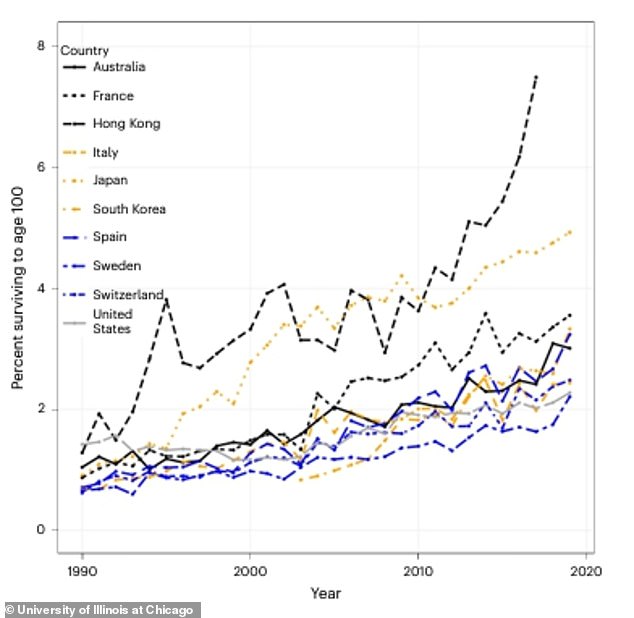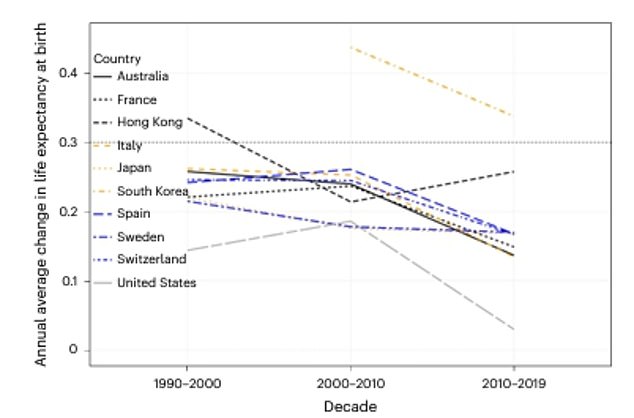Scientists predict how many of us will live to 100 – as figures reveal life expectancy increases are slowing around the world
We would probably all like to live to be a hundred years old.
But the chance of that happening is still very small, because the increase in life expectancy is slowing, experts say.
Researchers have found that we appear to be approaching the limits of human lifespan, despite huge leaps in life expectancy in the 19th and first half of the 20th centuries thanks to advances in medicine.
Some predictions from the 1990s even suggested that most children born today would reach their centenary age.
However, analysis has shown that children born in recent years still have only a 5.3 percent chance of celebrating their 100th birthday if they are female, and an even lower chance of 1.8 percent if they are male.
We’d probably all like to live to be a hundred years old. But the chance of that happening is still very small, because the increase in life expectancy is slowing, experts say.

Analysis has shown that children born in recent years still have just a 5.3 percent chance of celebrating their 100th birthday if they are female, and an even lower chance of 1.8 percent if they are male.
A team from the University of Illinois at Chicago examined mortality data from regions around the world, including Hong Kong, Australia, France and Spain.
They revealed that average life expectancy worldwide rose from 48 years in 1900 to 67 years in 1950, and again to 76 years at the turn of the millennium.
However, by 2021, this number had only increased to 77.
If the ‘radical life extension’ had gone ahead, this figure would currently be expected to be around 83, the team said.
Separate figures provided by the Office for National Statistics show that life expectancy in Britain has grown dramatically since 1841, when the first figures were available.
At that time, a child born would only live to be 40.2 years old if male and 42.3 years old if female.

Average life expectancy in the world rose from 48 years in 1900 to 67 years in 1950, and again to 76 years at the turn of the millennium. However, by 2021, this number had only increased to 77
This rose rapidly to 66.1 years for men and 70.6 years for women in 1950, and 75.6 years for men and 80.4 years for women in the year 2000.
However, new figures show that a child born in 2022 is expected to live to be 78.9 years old if male, and 82.8 years old if female – marking a marked slowdown.

Analysis of the new data also found that those living in Hong Kong have the best chance of celebrating their centenary (stock image)
Analysis of the new data also found that those living in Hong Kong have the best chance of celebrating their centenary: of children born in 2019, 12.8 percent of women and 4.4 percent of men will reach the milestone.
The team said there is no evidence to suggest that there has been or will be ‘radical life extension’ in the 21st century, and they argue that the focus now should be on extending the number of years one lives in good health.
Professor Stuart Olshansky, lead author of the study, said: ‘Most people living into old age today are living on time manufactured by medicine.
‘But these medical patches produce fewer years of life, even if done at an accelerated rate, implying that the period of rapid increases in life expectancy is now over.
‘We must now shift our focus to efforts that slow aging and extend lifespan.
‘Healthspan is a relatively new metric that measures the number of years someone has been healthy, and not just alive.’
In 1990, Professor Olshansky published a paper arguing that humans were approaching a life expectancy ceiling of about 85 years, and that the main gains had already been made.
“Our result overturns the conventional wisdom that the natural lifespan of our species lies somewhere on the horizon ahead of us – a life expectancy beyond where we are now,” he added.
The findings have been published in the journal Nature Aging.
